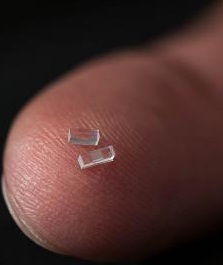Scaling down for laser physics fun at home
 Everybody wants their own particle accelerator, but colliding hadrons in the comfort of the living room has been impossible for most – until now.
Everybody wants their own particle accelerator, but colliding hadrons in the comfort of the living room has been impossible for most – until now.
A team of scientists from the U.S. Department of Energy's (DOE) National Accelerator Laboratory and Stanford University have reported an advance that could dramatically shrink particle accelerators for science and medicine.
Researchers used a laser to accelerate electrons in a nanostructured glass chip smaller than a grain of rice. Deviations carved into the chip allowed the electrons to significantly increase in energy as they flew along its length. The breakthrough employs commercial lasers and low-cost, mass-production techniques, likely to set the stage for a new generation of tabletop accelerators.
“We still have a number of challenges before this technology becomes practical for real-world use, but eventually it would substantially reduce the size and cost of future high-energy particle colliders for exploring the world of fundamental particles and forces,” said Joel England, the physicist who led the experiments.
“It could also help enable compact accelerators and X-ray devices for security scanning, medical therapy and imaging, and research in biology and materials science.”
Theoretically, the new “accelerator on a chip” could match the power of the DOE’s 3.2km-long machine in just 30 metres.
In its first ever demonstration, the new device achieved an amount of energy gained per length roughly 10 times the acceleration provided by the current DOE linear accelerator.
Applications for small, portable particle accelerators are vast – extending well beyond the realm of theoretical physics. They could drive compact free-electron lasers (used in many research scenarios), X-ray devices for use in combat or disasters, and provide more affordable medical imaging for hospitals and laboratories.
A dedicated website has been established for the ongoing project.








 Print
Print